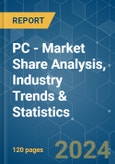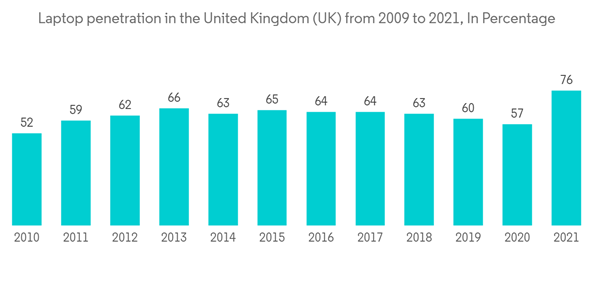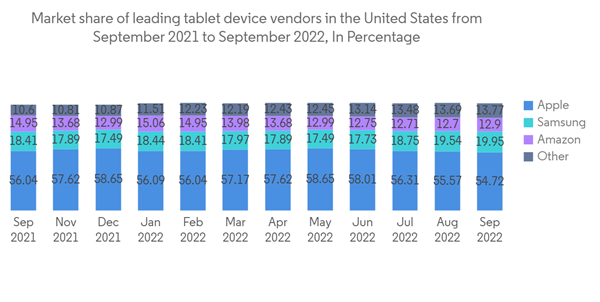The PC Market size is estimated at USD 204.07 billion in 2024, and is expected to reach USD 315.42 billion by 2029, growing at a CAGR of 9.10% during the forecast period (2024-2029).
In the forecast period, robust internet penetration and the reopening of schools, colleges, and offices are expected to pull up demand for personal computers across the world.
In October 2022, Lenovo recently introduced smarter technology innovations to redefine the future of the digital world. Innovations from Lenovo were introduced, including the first public display of rollable proofs of concept for smartphones and laptop computers. Rollable displays with computing built-in offer productivity, entertainment, and connection on a dynamic, changeable, and bigger screen, yet on a smaller device, solving consumer pain points and enhancing productivity in hybrid working.
In October 2022, Acer, one of the market's leading PC manufacturers, unveiled the launch of Swift Edge, the world's lightest 16-inch OLED laptop. The AMD-powered 16-inch OLED laptop weighs 1.17 kg. The latest model from Acer features several connectivity options and supports Microsoft Pluto.
This product will be delivered within 2 business days.
In the forecast period, robust internet penetration and the reopening of schools, colleges, and offices are expected to pull up demand for personal computers across the world.
Key Highlights
- Last year was a turning point in the history of the personal computer industry, firmly cementing the PC's position at the core of work, education, and pleasure. Given the persistent cloud of supply restrictions, the market's outstanding double-digit growth over 2020 says a lot about how robust PC demand has been over the last 12 months. From a long-term perspective, the biggest changes in the last year were the significant growth in PC consumption rates and penetration.
- With overall shipments of approximately 21.7 million PCs, Lenovo dominated the PC market in Q4 last year. It was also the largest shipper for the entire past year, reaching a record 82.1 million units, an increase of 13.1% over 2020. With Q4 shipments of 18.7 million units, HP positioned itself second, an increase of 9.5% over 2020. With 17.2 million units sold and an 8.9% phenomenal growth rate in Q4, Dell, which came in third, saw its market share rise by more than 1%.
- However, consumers are primarily concerned about worsening inflation, and spending on PCs and other equipment needs to catch up with more fundamental needs due to price rises across various goods and services. Although businesses are also concerned about the risks of inflation and rising interest rates, investing in PCs and IT in general is still essential for digital transformation as part of the post-Covid recovery.
- Laptops are useful, lightweight, and convenient to transport. Many individuals only buy laptops due to their smaller size, which allows them to use them for work either on a desk or anywhere else in their houses. The global demand for laptops is expected to hold much of the share in the global market.
- The world's need for tablets, laptops, and PCs rose during the COVID-19 pandemic. Social isolation and international laws governing remote employment have increased the need for networking equipment. Although the demand for personal computers has decreased as restrictions are gradually lifted and workplaces and institutions reopen, several organizations are shifting to permanent work-from-home, or hybrid, models post-COVID, thereby increasing the need for PCs across markets.
PC Market Trends
Laptop Demand Boosting the Market
- Rapid digitalization encourages people to use portable devices more often, such as laptops, to enhance work and educational processes. Due to their excellent qualities, such as their slim appearance and low weight, laptops are becoming increasingly popular globally. Also, the market mainly expands on the back of business sector expansion.
- The pandemic has increased demand for global online gaming platforms.Consumers are coming up with demands for high-technology, fast gaming laptops that can be easily carried anywhere. At present, laptops with high-resolution and wide displays are very popular among gamers. Gaming laptop manufacturers such as Razer, Asus, Lenovo, and others are constantly developing new models to meet changing customer demands.The increasing trend of gamers' spending is expected to impact the market in the near future positively.
- The most widely used laptop brands are Lenovo, Dell, and HP; together, they ship approximately 60% of all laptops sold globally. Since 2018, Lenovo has had the largest market share of any other company. HP is Lenovo's strongest rival in the global laptop market. Apple's shipments of desktop computers and laptops increased by 28% in the last year.
- The North American and European regions heavily influence the global laptop market. Also, Asia-Pacific's laptop market is expected to grow significantly during the projection period. Notably, growing government initiatives like "Make in India," "Made in China 2025," and "Digital India" would boost laptop sales in the area.
- Globally, the digital revolution is having a big influence on education. A significant change is taking place in the delivery of education and training. Students must find digital classrooms appealing. Artificial intelligence (AI), customized learning, and bring-your-own-device (BYOD) are emerging ideas that have changed how people teach, learn, and give assessments. In today's rapidly changing educational environment, portable IT devices such as laptops are in high demand for immersive learning opportunities.
- Over the past decade, laptop computing has advanced significantly, with improved power, battery life, mobility, and display quality, all contributing to a portable computer's appeal over a desktop computer. This is reflected in the United Kingdom's rising laptop penetration rate, which rose from 47% in 2009 to 76% last year.
North America is a Major Contributor
- In the United States alone, over 80 million PCs were sold in the past year, with over 20 million machines arriving in the last quarter. The variety of PCs sold in the United States ranges from desktops and workstation stationery items to tablets, laptops, netbooks, and other portable devices. Also, the United States has shipped approximately 19.5 million desktop, laptop, and workstation devices in the first quarter of the current year.
- As workers consistently returned to their workplaces, desktop shipping growth in the United States increased by 33%. Dell and HP Inc. are the market leaders in the United States PC industry, holding a combined market share of more than 50%, followed by Lenovo and Apple. There are also differences in the hardware options and the operating systems installed on the devices. Microsoft Windows, which accounts for more than half of the market share in the United States, and Apple's macOS, which accounts for about 25%, are the two most popular computer operating systems.
- As China battles with production hiccups brought on by COVID lockdowns, the worldwide PC supply chain has once again been constrained. While short-term supply may be limited, it had a less significant impact in this region than in others because the US market remains a priority for many providers.
- North America is one of the global leaders in high-speed internet infrastructure. with the strong resource of a network that enables internet access, management, commercial operations, and communication. by enabling users to complete several jobs quickly and simultaneously. Improved internet infrastructure contributes to the expansion of the PC industry in this region.
PC Industry Overview
The PC market is moderately fragmented, with four to five major players and many smaller ones present in the market. Several key market players are constantly working to bring advancements.A few prominent companies are entering into collaborations and expanding their global footprints in developing regions to consolidate their positions in the market. The major players in this market include Dell Inc., Lenovo Group Limited, Apple Inc., Asus, and Acer.In October 2022, Lenovo recently introduced smarter technology innovations to redefine the future of the digital world. Innovations from Lenovo were introduced, including the first public display of rollable proofs of concept for smartphones and laptop computers. Rollable displays with computing built-in offer productivity, entertainment, and connection on a dynamic, changeable, and bigger screen, yet on a smaller device, solving consumer pain points and enhancing productivity in hybrid working.
In October 2022, Acer, one of the market's leading PC manufacturers, unveiled the launch of Swift Edge, the world's lightest 16-inch OLED laptop. The AMD-powered 16-inch OLED laptop weighs 1.17 kg. The latest model from Acer features several connectivity options and supports Microsoft Pluto.
Additional Benefits:
- The market estimate (ME) sheet in Excel format
- 3 months of analyst support
This product will be delivered within 2 business days.
Table of Contents
1 INTRODUCTION
4 MARKET INSIGHTS
5 MARKET DYNAMICS
6 MARKET SEGMENTATION
7 COMPETITIVE LANDSCAPE
Companies Mentioned (Partial List)
A selection of companies mentioned in this report includes, but is not limited to:
- Lenovo Group Limited
- Dell Inc.
- Apple Inc.
- Acer Inc.
- ASUSTek Computer Inc.
- Microsoft Corporation
- The Hewlett-Packard Company(HP)
- Razer Inc.
- Micro-Star International Co.,
- Toshiba Corporation
- Samsung Electronics Co., Ltd
Methodology

LOADING...










